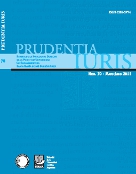Por favor, use este identificador para citar o enlazar este ítem:
https://repositorio.uca.edu.ar/handle/123456789/2959| Título: | El hombre en cuanto persona | Autor: | Lamas, Félix Adolfo | Palabras clave: | PERSONA HUMANA; IMPUTACION; NOMINALISMO; INMANENCIA; Tomás de Aquino, Santo, 1225?-1274 | Fecha de publicación: | 2011 | Editorial: | EDUCA Universidad Católica Argentina. Facultad de Derecho |
Cita: | Lamas, F. A. El hombre en cuanto persona [en línea], Prudentia Iuris. 2011, 70. Disponible en: https://repositorio.uca.edu.ar/handle/123456789/2959 | Resumen: | Resumen: El artículo examina el concepto de persona, en sus fuentes aporéticas y en el pensamiento de Santo Tomás de Aquino para, finalmente, analizar algunas de sus propiedades en orden a fundamentar una teoría de la imputación. La primera parte comienza con la consideración de los orígenes semánticos, históricos y teológicos de los términos persona e hypóstasis. Trata luego el problema teórico que este concepto implica para el pensamiento moderno, teniendo en cuenta el empobrecimiento de su Metafísica, como consecuencia del nominalismo, el principio de inmanencia y una deficiente concepción de la experiencia. Por último, se toman en consideración algunas consecuencias que dicho empobrecimiento tienen en el pensamiento contemporáneo. La segunda parte está dedicada a exponer la doctrina tomista que de un modo teóricamente definitivo dio solución, con elementos ontológicos aristotélicos, a los problemas planteados en la época Patrística. Se analiza el concepto de sustancia individual (o suppositum), que en la definición de persona opera analógicamente como género próximo, y el de naturaleza espiritual individuada, que opera como diferencia específica. Finalmente, se aportan textos del Aquinate acerca de la definición y de las diferencias conceptuales y ontológicas entre naturaleza y persona. En la tercera parte se exponen algunas propiedades, dividiéndolas en cuatro grupos de tesis: 1°) la persona como sujeto de atribución y dueña de sus proyectos vitales; 2°) como sujeto ontológicamente abierto al mundo, a los semejantes y a Dios; 3°) como sujeto consciente, libre y autónomo; 4°) el carácter ético de la persona, como sujeto de imputación y responsabilidad. Abstract: The article examines the concept of person, in its difficult sources and the thinking of Saint Thomas, finally, analyzing some of its properties for a base of the theory of the imputation. The first part begins with the consideration of the semantic, historical and theological origins of the concept of person and substance (hypostasis). It later shows the theoretical problem that this idea implies for the modern thought, considering the impoverishment of his Metaphysics, as a consequence of the nominalism, the principle of immanence and a deficient conception of the experience. Finally, some outcomes are considered that this impoverishment they have in the contemporary thought. The second part is dedicated to establish the thomist doctrine that of a theoretically definitive way provided solution, with aristotelian ontological elements, to the problems posed at the Patristic period. It analyses the concept of individual substance (or suppositum), that in the definition of person acts analogically like gender, and the one of individual spiritual nature, that acts like specific difference. Finally, are texts of the Aquinas about the definition and the conceptual and ontological differences between person and nature. In the third part some properties are exposed, dividing them in four thesis groups: 1°) the person as attribution subject and owner of its vital projects; 2°) as subject ontological open to the world, to people and God; 3°) as conscientious subject, free and independent; 4°) the ethical character of the person, as subject of imputation and responsibility. |
URI: | https://repositorio.uca.edu.ar/handle/123456789/2959 | Disciplina: | DERECHO | Derechos: | Acceso Abierto | Fuente: | Versión original impresa en Sistema de Bibliotecas UCA: Prudentia Iuris Nº 70, 2011 p.31-45. |
| Aparece en las colecciones: | PI - 2011 nro. 70 |
Ficheros en este ítem:
| Fichero | Descripción | Tamaño | Formato | |
|---|---|---|---|---|
| hombre-cuanto-persona-felix-lamas.pdf | 196,51 kB | Adobe PDF |  Visualizar/Abrir |
Visualizaciones de página(s)
947
comprobado en 22-dic-2025
Descarga(s)
1.007
comprobado en 22-dic-2025
Google ScholarTM
Ver en Google Scholar
Este ítem está sujeto a una Licencia Creative Commons

